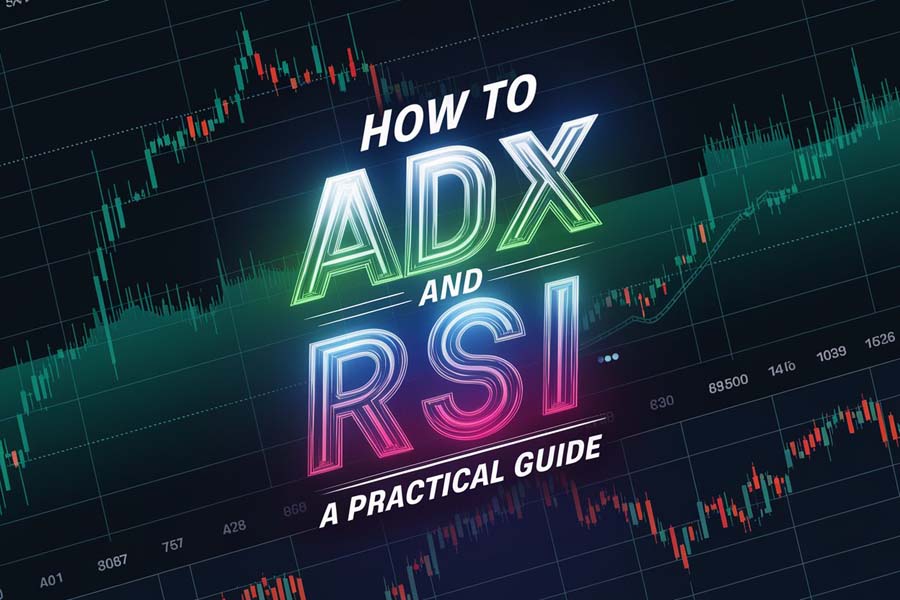Are you looking for a way to enhance your trading strategy and make more informed decisions in volatile markets? Trading with ADX and RSI is one of the most effective techniques to gain insights into market trends and momentum, helping you trade with more confidence. These two technical indicators, when combined, allow you to filter out false signals and maximize your profitability by identifying strong trends and overbought or oversold conditions.

In this comprehensive guide, we’ll walk you through how to use the Average Directional Index (ADX) and Relative Strength Index (RSI) together to time your entries and exits precisely. Whether you’re a beginner working with a regulated forex broker, or an experienced trader looking to refine your strategy, understanding how these indicators work together will give you a significant edge in the markets.
By the end of this article, you’ll have the knowledge to implement ADX and RSI into your trading strategy effectively. Working with a regulated forex broker, such as ASIC-regulated Opofinance, will also ensure a secure trading experience, helping you focus on what matters most: making profitable trades.
Understanding ADX and RSI: Why They Matter in Trading

Before diving into how to combine these two indicators, it’s essential to understand what each does independently.
What is ADX (Average Directional Index)?
The Average Directional Index (ADX) is an indicator that measures the strength of a trend, without regard to its direction. It can tell you whether the market is in a trending phase or in a ranging (sideways) phase. The values of ADX range from 0 to 100:
- 0–25: Indicates a weak trend or no trend at all.
- 25–50: Suggests a strong trend is forming.
- 50–75: Signifies a very strong trend.
- 75–100: Shows an extremely strong trend.
Using ADX helps traders avoid getting caught in sideways markets where trends are weak and price action is inconsistent. For instance, an ADX value below 25 generally signals that the market is range-bound, making it harder to capitalize on clear price movements. On the other hand, when ADX rises above 25, the market is trending, offering more reliable trading opportunities.
What is RSI (Relative Strength Index)?
The Relative Strength Index (RSI) is a momentum oscillator that measures the speed and change of price movements. It helps traders identify overbought or oversold conditions in the market. RSI ranges from 0 to 100:
- Above 70: The market is considered overbought, signaling a potential reversal or correction.
- Below 30: The market is considered oversold, suggesting a potential buying opportunity.
While RSI is useful for identifying market conditions where price movements may reverse, it’s not always reliable when used alone, especially in trending markets. By pairing RSI with ADX, you can significantly reduce the risk of acting on false signals, since ADX confirms whether the market has enough strength to justify the action indicated by RSI.
Read More: Ichimoku and RSI
How to Combine ADX and RSI for Trading: A Practical Guide

Combining ADX and RSI creates a powerful trading strategy that can enhance your decision-making process. Here’s a step-by-step guide on how to practically apply these indicators in your trading:
Step 1: Identify Trend Strength with ADX
The first step in using this strategy is to determine whether the market is trending or ranging by using the ADX:
- ADX above 25: The market is trending, so it’s a good time to consider trading.
- ADX below 25: The market is range-bound or weak, which could lead to indecision or false signals.
Once the ADX confirms a strong trend (above 25), you can move to the next step.
Step 2: Use RSI to Pinpoint Entry and Exit Opportunities
After confirming a strong trend using ADX, use the RSI to identify potential entry and exit points. Here’s how to interpret the RSI values within a trending market:
- In an uptrend (ADX above 25): Look for RSI to dip below 30, indicating an oversold condition and a potential buying opportunity.
- In a downtrend (ADX above 25): Look for RSI to rise above 70, indicating an overbought condition and a potential selling opportunity.
This dual approach ensures that you’re entering trades when both the market trend and the momentum align in your favor.
Step 3: Wait for Confirmation Before Acting
One of the key reasons traders combine ADX and RSI is to avoid jumping into trades too early. Even when RSI shows an overbought or oversold condition, it’s crucial to confirm that the trend is still strong using ADX. Only take action when both indicators align—i.e., when ADX confirms the trend and RSI indicates a favorable entry or exit point.
For example:
- In an uptrend, if RSI drops below 30, don’t immediately buy. First, confirm that ADX is still above 25 to ensure the uptrend is strong enough.
- In a downtrend, if RSI rises above 70, confirm that ADX is still above 25 before selling.
Step 4: Manage Your Risk
As with any trading strategy, risk management is critical. Here are some key risk management tips when trading with ADX and RSI:
- Set Stop-Loss Orders: Always use stop-loss orders to protect yourself from large, unexpected market movements. In an uptrend, place your stop-loss just below a key support level. In a downtrend, place it just above a key resistance level.
- Use Position Sizing: Adjust the size of your trades according to your risk tolerance. Never risk more than a small percentage of your trading account on any single trade.
Read More: bollinger bands and rsi strategy
Real-World Example: Combining ADX and RSI
Imagine you’re trading the EUR/USD currency pair on a forex broker platform. The ADX value is 35, indicating a strong uptrend. The RSI dips below 30, signaling that the market is oversold within this uptrend. You now have a potentially lucrative buying opportunity: the ADX confirms the trend’s strength, while RSI shows that the market is oversold, giving you an optimal entry point.
By waiting for both indicators to align, you increase the probability of success and avoid making impulsive trades based on just one signal.
Maximizing ADX and RSI with Advanced Trading Techniques

If you’re an experienced trader, there are several ways to take your ADX and RSI strategy to the next level.
Pro Tips for Advanced Traders
- Look for Divergence: Divergence between RSI and price can signal a weakening trend. For example, if the price is making higher highs, but RSI is making lower highs, it could be a sign that the trend is about to reverse. Combine this with a falling ADX to confirm a trend weakening.
- Multiple Timeframe Analysis: Analyzing ADX and RSI across multiple timeframes can provide a broader perspective. For instance, if you’re a short-term trader using a 15-minute chart, it’s a good idea to also check the 1-hour chart to ensure the trend aligns across different timeframes.
- Use with Moving Averages: Another advanced technique is to combine ADX and RSI with moving averages. For example, when the ADX is above 25, and the price is above the 50-period moving average, it reinforces the strength of the trend.
By incorporating these advanced techniques, you can refine your trading strategy and achieve more consistent results.
Best Timeframes for Trading with ADX and RSI
Timeframes are crucial when using technical indicators, and different traders may find success with different chart periods. Here’s how to select the best timeframe for your strategy:
- Scalpers: If you prefer short-term trades, the 5-minute or 15-minute chart may work best. These shorter timeframes allow you to capitalize on quick price movements.
- Swing Traders: Swing traders often use the 1-hour or 4-hour chart to capture medium-term trends. This gives more reliable signals as it reduces market noise.
- Position Traders: For long-term trades, daily or weekly charts are ideal. These timeframes are less affected by minor price fluctuations and help capture major market trends.
Each timeframe has its advantages, and the one you choose should align with your trading style and objectives. A good approach is to always analyze at least two different timeframes before entering a trade, to ensure consistency between signals.
Common Mistakes to Avoid When Trading with ADX and RSI
No strategy is foolproof, and trading with ADX and RSI requires careful attention. Here are some common mistakes to avoid:
- Trading in Sideways Markets: Many traders fail to recognize that ADX below 25 signals a weak or non-existent trend. Trying to trade in these conditions often leads to losses. Always check ADX before making a move.
- Ignoring Divergence: Divergence between price and RSI can signal a trend reversal. Ignoring this critical information can lead to missing out on significant opportunities or getting caught on the wrong side of the trade.
- Over-reliance on One Indicator: Using RSI or ADX in isolation can result in poor trade decisions. Always use these indicators together and, ideally, pair them with other tools like support and resistance levels or moving averages.
Avoiding these pitfalls will improve your trading performance and help you get the most out of your ADX and RSI strategy.
Read More: RSI Scalping Strategy
Backtesting and Optimization: Perfecting Your ADX and RSI Trading Strategy

One of the most critical steps in ensuring that your ADX and RSI trading strategy is robust and profitable is to backtest it before applying it to live markets. Backtesting allows you to see how your strategy would have performed in the past, providing valuable insights into its effectiveness under different market conditions. Additionally, optimizing your strategy through continuous testing and adjustments can help you refine it for maximum performance.
What is Backtesting?
Backtesting involves applying your trading strategy to historical market data to evaluate its performance. When done correctly, backtesting can help you:
- Identify Strengths and Weaknesses: You’ll be able to see which parts of the strategy work well and which areas need improvement.
- Estimate Profitability: It provides an idea of how much you could have earned or lost using the strategy in past conditions.
- Refine Entry and Exit Points: It helps in optimizing when to enter or exit a trade based on historical outcomes.
In the context of ADX and RSI, backtesting will allow you to determine how well these indicators have predicted profitable trades in various market conditions and across different timeframes.
How to Backtest Your ADX and RSI Strategy
To backtest your ADX and RSI strategy effectively, follow these steps:
- Choose a Trading Platform: Platforms like MetaTrader 5 (MT5), which is supported by Opofinance, offer built-in backtesting features. This makes it easy to apply historical data to your strategy.
- Select Your Timeframe and Asset: Pick a timeframe that matches your trading style (e.g., 15-minute chart for short-term trades or daily chart for long-term trades). Also, choose the asset you plan to trade, such as EUR/USD, gold, or stocks. Ensure that you have enough historical data for meaningful results.
- Set Your ADX and RSI Parameters: Before starting, decide on the specific values for your ADX and RSI indicators. A typical setup might be:
- ADX threshold: 25 to signal a strong trend.
- RSI thresholds: 30 for oversold and 70 for overbought conditions.
You can experiment with adjusting these values based on the asset and timeframe to see which works best.
- Run the Backtest: Use the platform’s backtesting feature to apply your ADX and RSI strategy to historical price data. Record the results, focusing on:
- Win rate: How often the strategy results in profitable trades.
- Risk/Reward Ratio: How much risk is being taken on for each unit of reward.
- Drawdowns: The maximum loss experienced before a new high is reached.
- Analyze the Results: After backtesting, review the data. Look for:
- Patterns: Did certain market conditions lead to higher profitability? For example, was the strategy more successful during trending markets?
- Failures: Were there consistent losses in specific scenarios, such as during high volatility or news events?
Optimizing Your ADX and RSI Strategy
Once you’ve backtested your strategy, the next step is optimization. Optimization involves adjusting different variables in your trading strategy to improve its overall performance. Here’s how to optimize your ADX and RSI strategy:
- Adjust Indicator Settings: Experiment with different settings for ADX and RSI. For example, try raising or lowering the ADX threshold for identifying a strong trend or adjusting the RSI levels to fine-tune your entry points. You can also explore using different timeframes for the RSI, such as the 14-period RSI or a 7-period RSI for more responsive signals.
- Test Across Different Timeframes: Don’t limit yourself to one timeframe. Backtest the strategy on multiple timeframes (e.g., 1-hour, 4-hour, daily) to see how it performs across different trading styles (scalping, swing trading, position trading).
- Optimize Risk Management: Try different risk management settings, such as stop-loss and take-profit levels, to find the best balance between risk and reward. For example, adjusting the stop-loss to slightly above or below key support or resistance levels can help you minimize losses.
- Combine with Other Indicators: Sometimes adding another indicator like moving averages or Bollinger Bands can help filter out false signals and improve accuracy. For example, combining ADX and RSI with a 50-period moving average can confirm trend direction more effectively.
- Run Forward Testing: After optimization, move to forward testing on a demo account or with small positions in a live account. This tests your optimized strategy in real-time market conditions to ensure that it performs well under live market stress.
Opofinance Services: Your Gateway to Hassle-Free Trading
Successful trading starts with a reliable broker. Opofinance, an ASIC-regulated broker, offers a secure and feature-rich platform that caters to traders of all levels. Here’s why Opofinance is the ideal broker for you:
- MT5 Brokers List: As part of the prestigious MT5 brokers list, Opofinance offers advanced charting tools, multiple order types, and fast execution speeds to help you get the most out of your trades.
- Social Trading Service: Whether you’re a beginner who wants to copy the trades of experts or an experienced trader looking to share your strategies, Opofinance’s social trading feature provides a unique opportunity to engage with the trading community.
- Safe and Convenient Deposits and Withdrawals: Opofinance offers a range of fast and secure payment methods, ensuring that you can manage your funds easily and focus on trading.

By partnering with Opofinance, you gain access to top-tier trading tools, educational resources, and a reliable support system to help you trade more effectively.
Conclusion
Trading with ADX and RSI offers a powerful combination of tools that can help you make more informed and profitable trading decisions. The ADX provides insight into the strength of market trends, while the RSI identifies overbought or oversold conditions, enabling you to time your entries and exits with greater precision. By combining these two indicators, you can avoid common trading pitfalls, filter out false signals, and optimize your trading strategy for both trending and volatile markets.
To ensure success, it’s important to backtest your strategy on historical data and continuously optimize it for different market conditions. This will give you confidence in your strategy before applying it to live trades, reducing risk and improving your profitability.
If you’re serious about improving your trading performance, working with a regulated forex broker like Opofinance ensures a secure trading environment. Their advanced tools, including MT5 and social trading services, allow you to apply the ADX and RSI strategy with ease and confidence.
By applying the techniques outlined in this article and committing to ongoing testing and refinement, you’ll be well-positioned to achieve more consistent results and success in your trading journey.
Key Takeaways:
- The ADX measures trend strength, while the RSI identifies market momentum, helping you time your trades more effectively.
- Combining both indicators reduces false signals and enhances your strategy for various market conditions.
- Regular backtesting and optimization ensure that your strategy remains profitable and adaptable over time.
- A reliable broker like Opofinance offers essential tools and support for implementing this strategy successfully.
Can ADX and RSI be used for day trading?
Yes, ADX and RSI can be used for day trading, particularly on shorter timeframes such as the 5-minute or 15-minute charts. However, be cautious of market noise, and always confirm trend strength using ADX before acting on RSI signals.
How do I know when a trend is ending using ADX?
When ADX starts to decline after reaching high levels (above 50), it could signal that the current trend is losing strength and may be approaching its end. Combine this with RSI to check for overbought or oversold conditions to time your exit.
Should I use ADX and RSI alone, or with other indicators?
While ADX and RSI are powerful together, it’s a good idea to combine them with other indicators like moving averages or support and resistance levels to enhance your strategy and filter out even more false signals.







